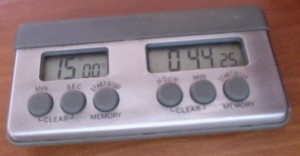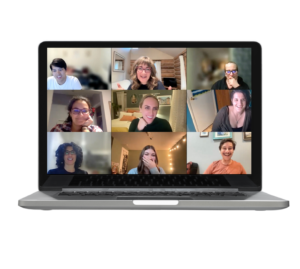
All you goal-makers and procrastinators out there, have you met my friend the timer?
This unassuming little tool unlocks massive productivity potential.
It may look like an inanimate object, but I give this little guy part of the credit for completing my schooling, working out, my home’s relatively organized state, staying on top of my email, and for this blog you’re reading, among many other things. I seriously don’t know where I’d be without it!
I recommend this tool to all of my clients as they tackle their own projects, and I wholeheartedly recommend it to you today.
If you are determined to make progress on your goals this year, but the prospect of getting started is overwhelming, harness the power of the almighty timer to help you. I recommend a kitchen timer—one that will merrily chirp “beepbeepbeep!” to announce your victory. (You may use the timer on your phone or computer, but beware the distractions that could work counter to your goals.)
You can set the timer for just 10, 20, or 30 minutes and BAM!—you’re making headway on that big intimidating project, or taking care of that nagging task you usually put off.
Here are four reasons the timer might just become your new best friend:
1. The timer doesn’t lie. It doesn’t forget or lose track. It’s unforgiving and doesn’t feel bad for you. It’s totally, brutally honest. No BSing your way around it. The timer tells it like it is. We humans have a remarkable ability to tell ourselves all kinds of stories and make all kinds of excuses. The timer keeps it real.
2. The timer can be incredibly motivating. How much more can I do in just the 6 minutes I have left? Can I “beat the timer”? (Parents, this works as well with eight-year-olds as it does with 38-year-olds.) Some of the work we want and need to do can feel boring. The timer can add a little element of fun. I swear, if you let it, this actually works.
3. The timer offers built-in accountability. When I set the timer and press start, I make a little promise that I am going to be writing for 30 minutes (or cleaning for 20 minutes, or sending email for 10 minutes). Most of the time, my integrity compels me to follow through. (Maybe this is the same force that gets me to go to the gym once I put my gym clothes on.) When no one but ourselves knows whether we do or don’t do something, it’s easy to get sidetracked. Knowing that “the timer knows” can help you follow through.
4. The timer gives you permission to stop. It tells you you’ve completed a chunk and you can feel good about that. Some of us tend to be hard on ourselves, and if we haven’t finished, we can run ourselves into the ground trying to do more now that we’ve finally started. The timer says, “Done for now!” Of course, if you choose to do more anyway, that’s great too.
What projects are you determined to make headway on this year? How do you plan to use the timer to help you?
Need help breaking through procrastination? I have the PERFECT solution for you!
Join The Life Workshop, my Get-It-Done group.
You’ll get tools, insights, community, accountability, and structure to get what matters to you DONE.

Setting a timer has definitely helped me stay on task while reading and writing in grad school. I tend to use the Pomodoro Technique, which provides a bit more structure than just setting a timer.
Thanks for your comment, Matt. Another reader mentioned the Pomodoro Technique after reading this post, too–says she lives by it! Sounds like a great technique for us all to try.